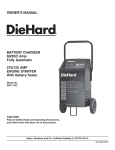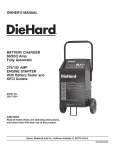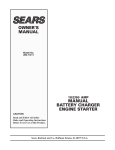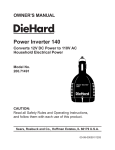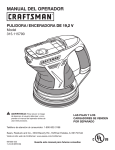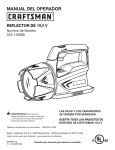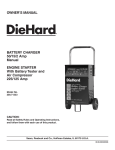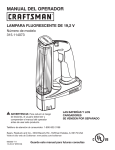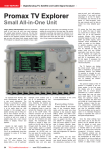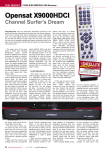Download Sears 200.71991 User's Manual
Transcript
OPERATOR’S MANUAL ® BATTERY CHARGER 70/40/20/4 Amp 300 AMP ENGINE STARTER With Battery Tester Model No. 200.71991 CAUTION: Read and follow all Safety Rules and Operating Instructions Before Every Use of this Product. Save these instructions. Sears, Roebuck and Co., Hoffman Estates, IL 60179 U.S.A. 00-99-000882/0808 Table of Contents SECTION Page 1. IMPORTANT SAFETY INSTRUCTIONS 1 2. personal precautions 2 3. preparing to charge 3 4. charger location 3 5. dc connection precautions 3 6. when battery is installed in vehicle 4 7. when battery is outside vehicle 5 8. battery charging - ac connections 6 9. product features 8 10. assembly instructions 8 11. operating instructions 10 12. engine start 11 13. calculating charge time 12 14. maintenance instructions 14 15. storage instructions 14 16. troubleshooting 14 DieHard Three-Year Full Warranty When operated and maintained according to all supplied instructions, if this DieHard product fails due to a defect in material or workmanship within one year from the date of purchase, return it to any Sears store or other DieHard outlet in the United States for free replacement. This warranty does not include fuses, which are expendable parts. This warranty gives you specific legal rights, and you may also have other rights which vary from state to state. Sears, Roebuck and Co., Hoffman Estates, IL 60179 For customer assistance or replacement parts, call toll-free from 7 am to 4:30 pm CT Monday through Friday: 1-800-SEARS-64 (1-800-732-7764) IMPORTANT: read and save this safety and instruction manual. 1. IMPORTANT SAFETY INSTRUCTIONS 1.1 SAVE THESE INSTRUCTIONS - The DieHard model 71991 Manual Battery Charger, offers a wide range of features to accommodate the needs for home or light commercial use. This manual will show you how to use your charger safely and effectively. Please read and follow these instructions and precautions carefully as this manual contains important safety and operating instructions. 1.2 Do not expose charger to rain or snow. 1.3 Use of an attachment not recommended or sold by the battery charger manufacturer may result in a risk of fire, electric shock or injury to persons. 1.4 To reduce the risk of damage to electric plug or cord, pull by the plug rather than the cord when disconnecting the charger. 1.5 An extension cord should not be used unless absolutely necessary. Use of an improper extension cord could result in a risk of fire and electric shock. If an extension cord must be used, make sure: • That the pins on the plug of the extension cord are the same number, size and shape as those of the plug on the charger. • That the extension cord is properly wired and in good electrical condition and; • That the wire size is large enough for the AC ampere rating of the charger as specified in Table 8.2. 1.6 Do not operate the charger with a damaged cord or plug; take it to a qualified serviceman. (Call customer service at: 800-SEARS-64). 1.7 Do not operate the charger if it has received a sharp blow, been dropped or otherwise damaged in any way; take it to a qualified serviceman. (Call customer service at: 800-SEARS-64). 1.8 DO NOT attempt to repair product yourself. To arrange for product repair, or for information about customer replaceable parts, call 1-800-SEARS-64 (1-800-732-7764). 1.9 In case of charger malfunction, DO NOT attempt to repair the charger yourself. To arrange for charger repair, or for information about customer replaceable parts, call 1-800-SEARS-64 (1-800-732-7764) 1.10 Do not disassemble the charger; take it to a qualified serviceman when service or repair is required. Incorrect reassembly may result in a risk of electric shock or fire. (Call customer service at: 800-SEARS-64). 1.11 To reduce the risk of electric shock, unplug the charger from the outlet before attempting any maintenance or cleaning. Turning off the controls will not reduce this risk. 1.12 WARNING: Pursuant to California Proposition 65, this product contains chemicals known to the State of California to cause cancer and birth defects or other reproductive harm. •1• WARNING – RISK OF EXPLOSIVE GASES. WORKING IN THE VICINITY OF A LEAD-ACID BATTERY IS DANGEROUS. BATTERIES GENERATE EXPLOSIVE GASES DURING NORMAL BATTERY OPERATION. FOR THIS REASON, IT IS OF UTMOST IMPORTANCE THAT YOU FOLLOW THE INSTRUCTIONS EACH TIME YOU USE THE CHARGER. TO REDUCE THE RISK OF BATTERY EXPLOSION, FOLLOW THESE INSTRUCTIONS AND THOSE PUBLISHED BY THE BATTERY MANUFACTURER AND THE MANUFACTURER OF ANY EQUIPMENT YOU INTEND TO USE IN THE VICINITY OF THE BATTERY. REVIEW THE CAUTIONARY MARKINGS ON THESE PRODUCTS AND ON THE ENGINE. 2. PERSONAL PRECAUTIONS 2.1 Consider having someone close enough by to come to your aid when you work near a lead-acid battery. 2.2 Have plenty of fresh water and soap nearby in case battery acid contacts your skin, clothing or eyes. 2.3 Wear complete eye protection and clothing protection. Avoid touching your eyes while working near the battery. 2.4 If battery acid contacts your skin or clothing, wash immediately with soap and water. If acid enters your eye, immediately flood the eye with cold running water for at least 10 minutes and get medical attention immediately. 2.5 NEVER smoke or allow a spark or flame in the vicinity of a battery or engine. 2.6 Be extra cautious to reduce the risk of dropping a metal tool onto the battery. It might spark or short-circuit the battery or other electrical part that may cause an explosion. 2.7 Remove personal metal items such as rings, bracelets, necklaces and watches when working with a lead-acid battery. A lead-acid battery can produce a short-circuit current high enough to weld a ring or the like to metal, causing a severe burn. 2.8 Use this charger for charging a LEAD-ACID battery only. It is not intended to supply power to a low voltage electrical system other than in a startermotor application. Do not use this battery charger for charging dry-cell batteries that are commonly used with home appliances. These batteries may burst and cause injury to persons and damage to property. 2.9 NEVER charge a frozen battery. 2.10 WARNING: Pursuant to California Proposition 65, this product contains chemicals known to the State of California to cause cancer and birth defects or other reproductive harm. •2• 3. PREPARING TO CHARGE 3.1 If it is necessary to remove the battery from the vehicle to charge it, always remove the grounded terminal from the battery first. Make sure all of the accessories in the vehicle are off, so as not to cause an arc. 3.2 Be sure the area around the battery is well ventilated while the battery is being charged. 3.3 Clean the battery terminals. Be careful to keep corrosion from coming into contact with your eyes. 3.4 Add distilled water to each cell until the battery acid reaches the level specified by the battery manufacturer. Do not overfill. For a battery without removable cell caps, such as valve regulated lead-acid batteries, carefully follow the manufacturer’s recharging instructions. 3.5 Study all of the battery manufacturer’s specific precautions while charging and recommended rates of charge. 3.6 Determine the voltage of the battery by referring to the vehicle owner’s manual and make sure that the output voltage selector switch is set to the correct voltage. If the charger has an adjustable charge rate, charge the battery at the lowest rate first. 4. CHARGER LOCATION 4.1 Locate the charger as far away from the battery as the DC cables permit. 4.2 Never place the charger directly above the battery being charged; gases from the battery will corrode and damage the charger. 4.3 Never allow battery acid to drip onto the charger when reading the electrolyte specific gravity or filling the battery. 4.4 Do not operate the charger in a closed-in area or restrict the ventilation in any way. 4.5 Do not set a battery on top of the charger. 5. DC CONNECTION PRECAUTIONS 5.1 Connect and disconnect the DC output clips only after setting all of the charger switches to the “off” position and removing the AC plug from the electrical outlet. Never allow the clips to touch each other. 5.2 Attach the clips to the battery and chassis, as indicated in steps 6.5, 6.6, and 7.2 through 7.4. •3• 6. FOLLOW THESE STEPS WHEN BATTERY IS INSTALLED IN vehicle A SPARK NEAR BATTERY MAY CAUSE BATTERY EXPLOSION. TO REDUCE RISK OF A SPARK NEAR BATTERY: NEGATIVE GROUNDED SYSTEM 6.1 Position the AC and DC cables to reduce the risk of damage by the hood, door, or moving engine parts. 6.2 Stay clear of fan blades, belts, pulleys and other parts that can cause injury. 6.3 Check the polarity of the battery posts. The POSITIVE (POS, P, +) battery post usually has a larger diameter than the NEGATIVE (NEG, N, -) post. 6.4 Determine which post of the battery is grounded (connected) to the chassis. If the negative post is grounded to the chassis (as in most vehicles), see step 6.5. If the positive post is grounded to the chassis, see step 6.6. 6.5 For a negative-grounded vehicle, connect the POSITIVE (RED) clip from the battery charger to the POSITIVE (POS, P, +) ungrounded post of the battery. Connect the NEGATIVE (BLACK) clip to the vehicle chassis or engine block away from the battery. Do not connect the clip to the carburetor, fuel lines or sheet-metal body parts. Connect to a heavy gauge metal part of the frame or engine block. 6.6 For a positive-grounded vehicle, connect the NEGATIVE (BLACK) clip from the battery charger to the NEGATIVE (NEG, N, -) ungrounded post of the battery. Connect the POSITIVE (RED) clip to the vehicle chassis or engine block away from the battery. Do not connect the clip to the carburetor, fuel lines or sheet-metal body parts. Connect to a heavy gauge metal part of the frame or engine block. 6.7 When disconnecting the charger, turn all switches to off, disconnect the AC cord, remove the clip from the vehicle chassis, and then remove the clip from the battery terminal. 6.8 See OPERATING INSTRUCTIONS for length of charge information. •4• 7. FOLLOW THESE STEPS WHEN BATTERY IS OUTSIDE VEHICLE. A SPARK NEAR THE BATTERY MAY CAUSE BATTERY EXPLOSION. TO REDUCE RISK OF A SPARK NEAR BATTERY: 7.1 Check the polarity of the battery posts. The POSITIVE (POS, P, +) battery post usually has a larger diameter than the NEGATIVE (NEG, N, -) post. 7.2 Attach at least a 24-inch-long 6-gauge (AWG) insulated battery cable to the NEGATIVE (NEG, N, -) battery post. 7.3 Connect the POSITIVE (RED) charger clip to the POSITIVE (POS, P, +) post of the battery. 7.4 Position yourself and the free end of the cable you previously attached to the NEGATIVE (NEG, N, -) battery post as far away from the battery as possible – then connect the NEGATIVE (BLACK) charger clip to the free end of the cable. 7.5 Do not face the battery when making the final connection. 7.6 When disconnecting the charger, always do so in reverse sequence of the connecting procedure and break the first connection while as far away from the battery as practical. 7.7 A marine (boat) battery must be removed and charged on shore. To charge it onboard requires equipment specially designed for marine use. •5• 8. 8.1 battery charging - ac connections GROUNDING AND AC POWER CORD CONNECTION INSTRUCTIONS – Charger should be grounded to reduce risk of electric shock. Charger is equipped with an electric cord having an equipmentgrounding conductor and a grounding plug. The plug must be plugged into an outlet that is properly installed and grounded in accordance with all local codes and ordinances. DANGER – Never alter the AC cord or plug provided - if it will not fit the outlet, have the proper outlet installed by a qualified electrician. An improper connection can result in a risk of an electric shock. This battery charger is for use on a nominal 120-volt circuit, and has a grounding plug that looks like the plug illustrated in sketch A in Figure 8.3. A temporary adapter, which looks like the adapter illustrated in sketches B and C, may be used to connect this plug to a two-pole receptacle as shown in sketch B if a properly grounded outlet is not available. The temporary adapter should be used only until a properly grounded outlet can be installed by a qualified electrician. DANGER – Before using adapter as illustrated, be certain that center screw of outlet plate is grounded. The green-colored rigid ear or lug ex tending from adapter must be connected to a properly grounded outlet– make certain it is grounded. If necessary, replace original outlet cover plate screw with a longer screw that will secure adapter ear or lug to outlet cover plate and make ground connection to grounded outlet. •6• 8.2 Recommended minimum AWG size for extension cords for battery chargers: AC input rating, a amperes But less At least than 0 2 2 3 3 4 4 5 5 6 6 8 8 10 10 12 12 14 14 16 16 18 18 20 25 (7.6) 18 18 18 18 18 18 18 16 16 16 14 14 AWG size of cord Length of cord, feet (m) 50 100 150 (15.2) (30.5) (45.6) 18 18 16 18 16 14 18 16 14 18 14 12 16 14 12 16 12 10 14 12 10 14 10 8 12 10 8 12 10 8 12 8 8 12 8 6 a If the input rating of a charger is given in watts rather than in amperes, the corresponding ampere rating is to be determined by dividing the wattage rating by the voltage rating ± for example: 1250 watts/125 volts = 10 amperes 8.3 Grounding Methods •7• 9. features 3 4 5 2 6 1 7 8 1. Ammeter 2. Volt Meter 3. Foam Grip 4. Fiber Glass Clamp Rod 5. Clamps 6. Charge Rate Selector Switch 7. Timer 8. Wheel 10. assembly instructions It is important to fully assemble your charger before use. Follow these instructions for assembly: ITEM QTY NO. DESCRIPTION 1 2 axle bracket 2 1 axle with pin holes 3 2 wheel 4 2 screw, 10-32 x 1/2, self tapping 5 2 screw, 1/4-20 x 3/4, self tapping 6 1 wheel charger foot 7 2 hubcap, black 8 2 hairpin cotter 9 2 nylon washer 10 4 screw, 8-18 x 1/2 sheet metal 11 1 handle assembly 12 1 fiberglass clamp rod 13 1 foam handle grip TOOLS NEEDED •8• 5/16” Wrench or Nut Driver 3/8” Wrench or Nut Driver Screwdriver (Flat Blade) Screwdriver (Phillips) Hammer 10.1 First, carefully lay the charger on its front to prepare for assembly. 10.2 Assemble the foot (Item 6) using two ¼-20 screws (Item 5) and tighten securely. 10.3 Attach the two axle brackets (Item 1) using one 10-32 screw (Item 4) in each. The brackets should have one end hooked into the slot in the charger base. (Do not completely tighten the screws (Item 4) at this time). 10.4 Slide the axle (Item 2) into the brackets (Item 1) until centered on the charger. 10.5 Slide one wheel (Item 3) onto the axle with the recessed hub facing out as shown. 10.6 Next insert pin (Item 8) thru axle hole. 10.7 Repeat this process for the other wheel and when both wheels have been pinned to axle, finish tightening the two axle bracket screws (Item 4). 10.8 Snap hub caps (Item 7) onto each wheel to cover the pin and axle. 10.9 Next lift the charger upright so that it rests on the wheels and foot. 10.10 Remove the two top side screws (Item 9) from each side of the charger. 10.11 Verify that the foam handle grip (Item 12) is on the handle assembly (Item 10), install if needed. 10.12 Insert the fiberglass clamp rod (Item 11) into the pierced holes on the inside of the handle (Item 10). 10.13 Align the handle assembly (Item 10) with charger and reinstall the side screws (Item 9). Do not over tighten. 10.14 Charger assembly is now complete. Battery clips can be clamped to the fiberglass rod (Item 11) for convenient storage. 10.15 Do not attach clips to the foam area of handle as this will damage the foam grip. •9• 11. operating instructions 11.1 TIMER The main function of the timer is to prevent over charging while allowing a battery time to obtain a satisfactory charge. To properly set the timer you must know the size of the battery in ampere hours or reserve capacity in minutes and the state of charge. Often the state of charge is not known, this is one reason why the timer was limited to 2.25 hours. With the aid of a battery load tester the state of charge can be obtained within a few seconds. For example, the average size automotive battery at a 50% state of charge will require 1 to 1.5 hours of charging at the 40 amp rate to reach the full charge state. For the same battery with the timer set to its maximum, 2.25 hours, over charging will occur, but not likely cause harm to a battery that was otherwise in good condition. When the charge state is not known, start out with a timer setting of one hour or less, or use the automatic setting. 11.2 HOLD This position defeats the timer function, allowing for continuous operation. AUTOMATIC MODES: Put the timer in the HOLD position when the battery charger is in one of the automatic modes, otherwise the timer will shut the charger off when the set time expires regardless of whether the charge is complete or not. The green “charged” LED will light and the fan will shut off when the charging is complete. MANUAL MODES: Use when you want to charge more than 2.25 hours. Be sure to monitor the charging procedure and stop it when the battery is charged. Not doing so may cause damage to your battery. 11.3 AMP RATE SELECTOR SWITCH Use the amp selector switch to select the charge rate or engine starting setting you require. • 10 • 11.4 AMMETER The Ammeter indicates the amount of current measured in amperes that is being drawn by the battery. For example, in the 40 amp charge rate a typical discharged battery will initially draw approximately 40 amps. As the battery continues to charge, current will taper to 15 to 20 amps at full charge. The Start area of the meter indicates a high rate of current being drawn from the charger. When cranking an engine, the starter motor draws upwards to 200-300 amps. The meter needle will be at the extreme right side of the start area. Sometimes a battery for the first few minutes of its charge will draw more than 70 amps, in this case the needle may be within, but not all the way over, to the right side of the start area. The 4 amp charge rate may indicate some activity on the meter. The meter does not have the resolution to display this low rate. 11.5 VOLTMETER The Voltmeter indicates the voltage at the battery terminals. Use as follows: 1. The charger need not be plugged into an AC outlet. The timer should be in the OFF position. Then connect the charger following instructions in Sections 6 and 7. 2. Observe the meter indication. Keep in mind that this reading is only a battery voltage reading, a false surface charge may mislead you. We suggest that you turn on your headlights for a couple of minutes before you read the meter. Read a couple of minutes after you have shut the headlights off. If the reading is less than 10.5-volts, the battery may be bad or the connections at the charger may be poor. If the reading is 10.5-volts to 12.8-volts the battery is low – recharge it. If the reading is above 12.8-volts the battery is charged. 12. engine start 12.1 Set the charge rate switch and the timer to the OFF positions. 12.2 With the charger unplugged from the AC outlet, connect the charger to the battery following instructions given in section 6. 12.3 Plug the charger AC power cord into the AC outlet, and then move the timer from OFF to the HOLD position. 12.4 Set the amp rate selector switch to the engine start position and then crank the engine until it starts or 5 seconds passes. NOTE: During extremely cold weather, or if the battery is under 2 volts, charge the battery for five minutes before cranking the engine. 12.5 If the engine fails to start, charge the battery for 5 more minutes before attempting to crank the engine again. 12.6 After the engine starts, move the amp rate selector switch to OFF and unplug the AC power cord from the outlet before disconnecting the battery clamps. • 11 • IMPORTANT: Using the ENGINE START feature WITHOUT a battery installed in the vehicle could cause damage to the vehicle’s electrical system. If the engine does turn over, but never starts, there is not a problem with the starting system; there is a problem somewhere else with the vehicle. STOP cranking the engine until the other problem has been diagnosed and corrected. 13. calculating charge time 13.1 The Chart Method Use the following table to more accurately determine the time it will take to bring a battery to full charge. First, identify where your battery fits into the chart. • Small batteries – motorcycle, garden tractors, etc. – are usually rated in Ampere Hours (AH). For example: 6, 12, 32 AH etc. • Batteries in cars and smaller trucks are usually rated in Reserve Capacity (RC), Cold-Cranking Amps (CCA), or both. • Marine or deep-cycle batteries are usually rated in Reserve Capacity (RC). • NR means that the charger setting is NOT RECOMMENDED. Find your batteries rating on the chart below and note the charge time given for each charger setting. The times given are for batteries with a 50-percent charge prior to recharging. Add more time for severely discharged batteries. CHARGE RATE/ CHARGING TIME - HOURS BATTERY SIZE/RATING SMALL BATTERIES CAR/ TRUCKS 4 AMP 20 AMP 40 AMP 70 AMP 6 - 12 AH 2-4 NR NR NR 12 - 32 AH 4 - 10 NR NR NR 200 - 315 CCA 40 - 60 RC 11 - 14 60 - 90 min. 30 - 40 min. 20 - 30 min. 315 - 550 CCA 60 - 85 RC 14 - 18 90 - 120 min. 45 min 1 hr 30 - 40 min. 550 - 1000 CCA 85 - 190 RC 18 - 35 2 - 3.5 hrs. 1 - 2 hr 45 - 60 min. 80 RC 18 105 min. 1 hr NR 140 RC 27 2 hrs., 45 min. 1 hr and 15 min NR 160 RC 30 3 hrs. 1.5 hrs NR 180 RC 33 3.5 hrs. 2 hrs NR Motorcycle, garden, tractor, etc. MARINE/DEEP CYCLE • 12 • 13.2 The Hydrometer or Electronic Method To find the time needed to fully charge your battery, determine the battery’s charge level with a hydrometer or electronic Percent-of-Charge Tester. The following table will help you convert hydrometer readings to percent of charge values. SPECIFIC GRAVITY OF CHARGE PERCENT OF CHARGE PERCENT NEEDED 1.265 100% 0% 1.225 75% 25% 1.155 25% 75% 1.120 0% 100% When you know the percent of charge and the Amp Hour (AH) rating of your battery, you can calculate the approximate time needed to bring your battery to a full charge. To convert Reserve Capacity to Amp Hours, divide Reserve Capacity by 2, and add 16: Amp Hours = Reserve Capacity + 16 2 NOTE: The Reserve Capacity can be obtained from the battery specification sheet or the owner’s manual. To calculate time needed for a charge: • Find the percent charge needed. (A battery at 50 percent charge that will be charged to 100 percent needs another 50 percent (.50)). • Multiply the Amp Hour rating by the charge needed (.50) and divide by the charger setting (2, 15, or 60 amps). • Multiply the results by 1.25 and you will have the total time needed, in hours, to bring the battery to full charge. • Add one additional hour for a deep-cycle battery. Example: Amp Hour Rating x charge needed Charger Setting x 100 (AH Rating) x .50 (charge needed) x 20 (Charger Setting) 1.25 = 1.25 = hours of charge 3.125 hours 100 x .50 2.5 x 1.25 = 3.125 20 You would need to charge your 100-Ampere Hour Battery for a little more than 3 hours at the 20-Amp charge rate using the above example. • 13 • 14. maintenance instructions 14.1 Before performing maintenance, unplug and disconnect the battery charger (see sections 6.7 and 7.6). 14.2 After use, use a dry cloth to wipe all battery corrosion and other dirt or oil from the clips, cords, and the charger case. 14.3 Through routine maintenance, ensure all user installed parts are secure. 14.4 Servicing does not require opening the unit, as there are no user-serviceable parts. 15. storage instructions 15.1 Store the charger unplugged and in an upright position. The cord will still conduct electricity until it is unplugged from the outlet. 15.2 Store inside, in a dry, cool place (unless you are using a UL Listed, onboard Marine Charger). 15.3 Store the clips on the fiberglass clamp rod. Do not store them on the handle, clipped together, on or around metal, or clipped to the cables. • 14 • 16. troubleshooting PROBLEM POSSIBLE CAUSE SOLUTION/REASONS No reading on the ammeter. Clips are not making a good connection. Check for poor connections to battery and frame. Make sure connecting points are clean. Rock clips back and forth for a better connection. 4-amp charge rate is being used. Ammeter may show no activity at the 4-amp charge rate. Battery is severely discharged. Continue charging battery for two more hours. If problem continues, have the battery checked. Ammeter reading stays high. Wrong battery voltage Ammeter reads less than selected charge rate when charging a discharged battery The charger is making an audible clicking sound. Charger makes a loud buzz or hum. Verify that you are using a 12-volt, lead-acid battery. Extension cord is too long or wire gauge is too small. Use a shorter or heavier gauge extension cord. Weak cell or sulfated plate in battery. A sulfated battery will eventually take a normal charge if left connected. If the battery will not take a charge, have it checked. Battery is only partially discharged. Continue to charge the battery. Circuit breaker is cycling. The settings may be wrong. Check the charger settings. Battery is defective. Have the battery checked. Shorted battery clips. Circuit breaker cycles when current draw is too high. Check for shorted cables and replace if necessary. Severely discharged battery, but otherwise it is a good battery. Allow charging to continue until battery has a chance to recover sufficiently to take a charge. If more than 20 minutes, stop charging and have the battery checked. Reverse connections at battery. Shut the charger off and correct the lead connections. Transformer laminations vibrate (buzz). No problem, this is a normal condition. Shorted SCR (hum). Have charger tested by a Sears or other qualified service dealer. • 15 • PROBLEM POSSIBLE CAUSE SOLUTION/REASONS Short or no start cycle when cranking engine. Drawing more than 300 amps. Crank time varies with the amount of current drawn. If cranking draws more than 300 amps, crank time may be less than 3 seconds. Failure to wait 3 minutes (180 seconds) between cranks. Wait 3 minutes of rest time before the next crank. Clips are not making a good connection. Check for poor connection at battery and frame. AC cord and/or extension cord is loose. Check power cord and extension cord for loose fitting plug. No power at receptacle. Check for open fuse or circuit breaker supplying AC outlet. The charger may be heated up. The thermal protector may have tripped and needs a little longer to close. Make sure the charger vents are not blocked. Wait and try again. Battery may be severely discharged. On a severely discharged battery, charge for 10 to 15 minutes in the 40 amp manual rate to help assist in cranking. AC outlet is dead. Check for open fuse or circuit breaker supplying AC outlet. Poor electrical connection. Check power cord and extension cord for loose fitting plug. Clips are not making a good connection. Check for poor connection at battery and frame. Make sure connecting points are clean. Rock clips back and forth for a better connection. Battery is severely discharged. If your battery does not have 4 volts, you need to switch to the 40A Manual mode for five or ten minutes and then switch back to Automatic mode at the desired charge rate. Charger will not turn on when properly connected. The battery is connected and the charger is on, but is not charging. • 16 • • 17 •
























